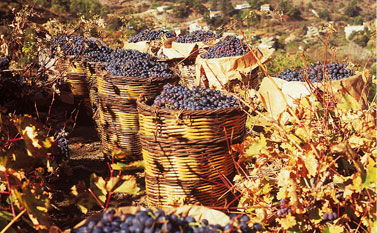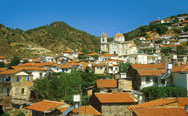- Villa search

- Canaries
- Caribbean
- Croatia, Bulgaria and Hungary
- Cyprus
- Florida
- France and Corsica
- Greece
- Italy
- Lakes and Mountains
- Madeira
- Malta and Gozo
- Portugal
- South Africa
- Spain - Balearics
Information

Grapes harvested in the Troodos region
For walkers wanting a taste of the good life, and a reward for their exertions, the Troodos region is famed for its wineries. The village of Agros produces both rose liqueur and rose water in its distilling centre, while the wine-producing village of Omodos is one of the most beautiful in the area.
With more than 770 plant species in the region, the Troodos is a paradise for botanists. The area's geology is also of worldwide importance with scientists particularly drawn to examples of plutonic rock created by the crystallisation of magma which took place under the ocean bed millions of years ago.
Rare species of flora and rocks can also be seen in the Pinus Nigra forest. You might well stumble, passing through its dense thickets, across one of the largest juniper trees on the island. It’s 800 years old.
'Akamas is an area of incomparable natural beauty and a dazzling array of wildlife'
Interested in monasteries? Head for Kykkos to see the immaculately-preserved 12th century building.
In the Pitsylia area, the mountainous region east of Troodos, there are three noteworthy Byzantine churches that have UNESCO World Heritage status. Pitsylia is also known for its apples, pears, cherries, peaches, grapes and seasonal vegetables, while its prettiest village, Alona, has stone-built houses steeped in greenery.

Walkers in this area will pass through dense hazelnut plantations on their way to the Caves of Digenis, a hiding place for the partisans who fought for independence from 1955 to 1959.
Akamas mountains
The Akamas range, in the north-west, towers over the picturesque and undeveloped region in which Aphrodite bathed and had her trysts with Adonis. The Aphrodite Trail gives walkers spectacular views over coastal rock formations, limestone cliffs and beaches, including the protected nesting ground for loggerhead turtles at Lara Bay.Akamas is an area of incomparable natural beauty and a dazzling array of wildlife. The peninsula, a rugged thumb-shaped strip of land, has a range of rocky hiking trails on which ornithologists can spot 168 bird species. The endemic Glaucopsyche butterfly is the region’s symbol, highlighting the significance of nature in this part of the island. Blossoms and wild flowers break through even in the depths of winter; February springs to life with crown daisies and cyclamens.
Petratis Gorge, the gateway to the Akamas Peninsula, has one of the most spectacular coastal vistas in the area – it’s especially pretty in spring when goats graze in meadows lit up by yellow oxeye daisies. Goats are even more noticeable as the only residents of three abandoned Turkish villages in the region.
Paphos
The massive pine forest in the Paphos area has a wealth of nature trails providing gentle slopes for those seeking less challenging routes. The station at Stavros tis Psokas, at the heart of the forest, has a cafeteria and picnic site.Tips for walkers
If you’re a newcomer to the pleasures of hiking, try some walks at home to prepare yourself.
Consider how much planning you’re prepared to do and how experienced you are when choosing whether to walk independently or book a place on an organised walk.
If walking independently, choose routes that suit your ability and interests. Combine walks with stop-offs at tavernas to soak up the very best of Cypriot hospitality.
Take bottled water, a hat, sun-cream and plasters in a comfy backpack.
Guided walks mean that you don’t have to spend time planning your hikes – and you’ll know you’ll be shown the highlights of the area.
Independent walkers can be more flexible with their route, stop-offs and pace and have the satisfaction of going wherever their fancy takes them.
When to go
Mid to late March will delight nature lovers with bouncing baby goats and a blooming profusion of wild flowers.
April and October are prime months for ornithologists, thanks to the island’s position on one of the major north-south migratory routes.
Summer months are too hot for much walking and winter months bring sporadic bursts of stormy weather.
home | destinations and editorial | villa search | property for sale | car hire | flights | services
villaseek blog | contact villaseek | links and resources | advertise your villa© Dune Root Ltd and Villaseek.com 2012 - Caribbean
- Canaries